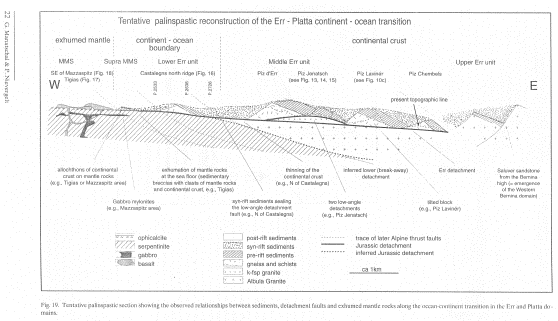




 |
 |
 |
 |
 |

The Platta nappe has numerous exposures of oceanic rocks. We were interested in what Tethyan oceanic “crust” looked like—was it dominated by serpentinite, or were there abundant gabbro bodies? What were the gabbro bodies’ dimensions and shape? We followed a field guide by Manatschal et al (Eclogae geol. Helv. 96 (2003)) to examine the exhumation history of a gabbro body from its intrusion into mantle rock to its exposure at the seafloor. We found the following stratigraphy: gabbro, breccias dominated by serpentinite and gabbro clasts, breccias dominated by sedimentary fragments, breccias with pillow lava clasts, and finally, red bedded shales.
The Err-Platta nappes expose the continent-ocean transition of the southern margin of the Piemont-Liguria ocean (see Figure below). The Platta nappe contains dominantly oceanic rocks with small slivers of allochthonous continental crust all overlain by post-rift sediments. Serpentinized mantle lherzolite is strongly tectonized; fault planes are designated by ophicalcite breccias. There are isolated bodies of gabbro within the serpentinite. Basaltic dikes cut both serpentinite and gabbros. Denudation of serpentinized mantle was not accompanied by significant magmatism; it was accomplished primarily by tectonism.

|
 Kay “VonTrapp” Achenbach nearly bursts into song. |
|
Manatzschal, G. and Bernoulli, D.,
1999. Architecture and tectonic evolution of nonvolcanic margins: Present-day
Galicia and ancient Adria, Tectonics, v. 18, no. 6, p. 1099-1119.
Manatschal, G., 1999. Fluid- and reaction-assisted low-angle normal faulting:
evidence from rift-related brittle fault rocks in the Alps (Err Nappe, eastern
Switzerland), Journal of Structural Geology, v. 21, p. 777-793.
Manatschal, G. Marquer, D., Fruh-Green, G.L., 2000. Channelized fluid flow and
mass transfer along a rift-related detachment (Eastern Alps, southeast Switzerland),
GSA Bulletin, v. 112, no. 1, p. 21-33.